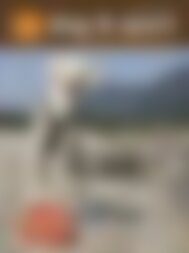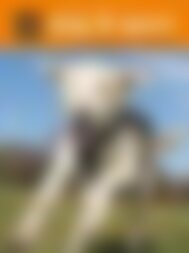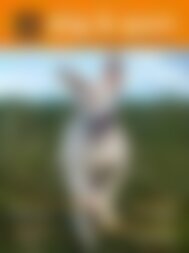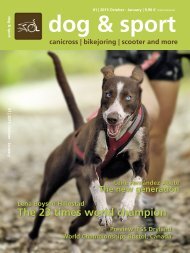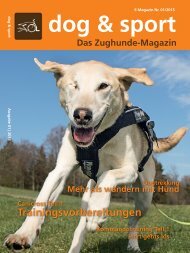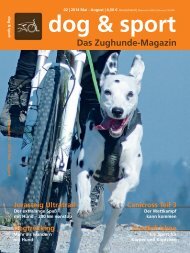dog & sport international 01/2015
dog & sport – Canicross, Bikejöring, Scooter and more! The inaugural issue of our international magazine in English, connecting the whole world of harness dog sports. Join us on our brand new journey… Everything you need to know about harness dog sports! Inside our first issue: Interview with Lena Boysen Hillestad Junior training camp in Norway – an exemplar Canicross – the first training steps Command training – that sounds strict Canicross belts tested Preview IFSS World Championships Canada Harnesses – what is important Scotland and Switzerland introduce themselves and much more… Come and join us into the fascinating world of Canicross, Bikejoring, Scooter and more – 52 pages with everything you need to know about harness dog sports!
dog & sport – Canicross, Bikejöring, Scooter and more! The inaugural issue of our international magazine in English, connecting the whole world of harness dog sports. Join us on our brand new journey…
Everything you need to know about harness dog sports!
Inside our first issue:
Interview with Lena Boysen Hillestad
Junior training camp in Norway – an exemplar
Canicross – the first training steps
Command training – that sounds strict
Canicross belts tested
Preview IFSS World Championships Canada
Harnesses – what is important
Scotland and Switzerland introduce themselves
and much more…
Come and join us into the fascinating world of Canicross, Bikejoring, Scooter and more – 52 pages with everything you need to know about harness dog sports!
You also want an ePaper? Increase the reach of your titles
YUMPU automatically turns print PDFs into web optimized ePapers that Google loves.
Tellington TTouch<br />
Emotions and physical posture are<br />
deeply entwined. An animal’s<br />
body stressed by injury or excessive<br />
tiredness can become less effective<br />
and more vulnerable to situations<br />
that would not normally concern<br />
him. On the other hand, the posture<br />
of an animal suffering from emotional<br />
trauma is affected by the<br />
tightening of certain muscle groups.<br />
This can become habitual posture<br />
so a vicious circle can develop, the<br />
emotional state feeding the physical<br />
state and visa versa. The light,<br />
non-habitual movement of TTouch<br />
body and groundwork exercises<br />
create the potential for improvement<br />
and change in posture and<br />
emotion.<br />
The Tellington TTouch was founded<br />
and developed by Linda Tellington-<br />
Jones, closely supported and documented<br />
by her sister Robyn Hood. It<br />
was a progression from Linda's study<br />
of the Feldenkrais Technique, a<br />
system of mind-body integration<br />
for humans. This technique increases<br />
an individual’s awareness of<br />
their body and movement, enhancing<br />
their ability to learn how to<br />
achieve their mental and physical<br />
potential. Impressed with the effects<br />
on herself and her riding students,<br />
Linda began to wonder how<br />
this work could be translated into<br />
helping animals who do not have<br />
the human ability to follow complex<br />
verbal direction to the nonhabitual<br />
movements and thought<br />
processes of Dr Feldenkrais' work.<br />
She began to experiment and the<br />
Tellington TTouch was born, breaking<br />
through that communication<br />
barrier to create similar possibilities<br />
for animals by using non-habitual<br />
movements of the skin and slow<br />
groundwork exercises.<br />
How might TTouch apply to Sport<br />
Dogs?<br />
It is well known that although a<br />
fulfilling lifestyle for many working<br />
breeds, the work of a <strong>sport</strong><br />
<strong>dog</strong> can be physically and emotionally<br />
demanding. Periods of waiting<br />
in the van, bursts of physical<br />
activity or long runs, tracks or<br />
searches in difficult conditions and<br />
sometimes inclement weather. In<br />
these special partnerships, the <strong>dog</strong><br />
and handler give the best that they<br />
can give, sometimes to the point of<br />
exhaustion.<br />
If a <strong>dog</strong> has a good awareness of his<br />
body and how to move in balance,<br />
there is greater confidence and ability<br />
to take on board the new tasks<br />
required. TTouch enhances the<br />
<strong>dog</strong>'s agility and ability to move<br />
over obstacles and difficult terrain<br />
safely. The other great bonus is that<br />
TTouch can help to cement a new<br />
partnership and bring close working<br />
co-operation more quickly.<br />
If a <strong>dog</strong> has suffered a physical injury,<br />
TTouch can be used alongside<br />
veterinary treatment and veterinary<br />
physiotherapy to help with pain<br />
relief and to aid recovery. During<br />
recovery, some <strong>dog</strong>s learn to move<br />
in a habitual way to 'guard' the old<br />
injury. Stress is put on other parts of<br />
the body, posture is affected and<br />
the <strong>dog</strong> may lose some emotional<br />
confidence as a result. Body and<br />
groundwork exercises at this stage<br />
can help the <strong>dog</strong> to return to it's<br />
full physical and emotional<br />
potential.<br />
TTouch Bodywork<br />
TTouch uses light movements of<br />
the skin to influence the nervous<br />
system and is not a deep muscle<br />
massage or manipulation of the<br />
skeleton. The skin is moved in a<br />
clockwise circle and a quarter or<br />
gentle lifts or a combination of the<br />
<strong>dog</strong> & <strong>sport</strong> | 45








